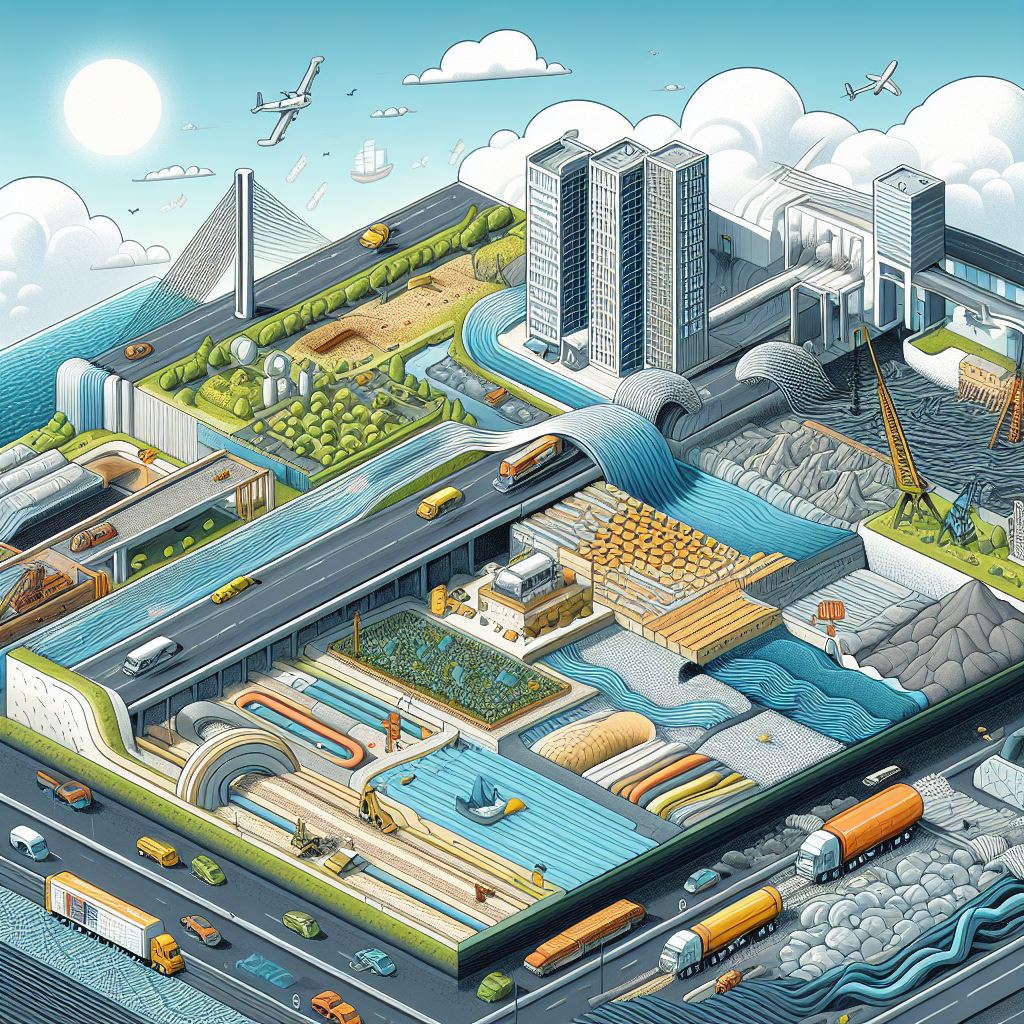
Geosynthetics in Civil Engineering: Modern Uses & Benefits
Introduction
Geosynthetics, a pivotal innovation in civil engineering, have revolutionized the way civil construction materials are used, offering a myriad of applications and benefits. This article aims to provide an in-depth, comprehensive exploration of geosynthetics, focusing on their transformative role in modern civil engineering. It is tailored for civil engineers, infrastructure planners, students in civil engineering and architecture, construction industry professionals, and environmentalists interested in sustainable construction.
Definition and Types of Geosynthetics
Definition
Geosynthetics are synthetic products used to solve civil engineering problems. They are integral to soil stabilization, erosion control, and drainage systems, offering a versatile range of applications in civil construction.
Types
Geosynthetics are categorized into several types, including:
- Geotextiles: Fabric materials used primarily for filtration and separation.
- Geomembranes: Impermeable liners utilized for containment and environmental protection.
- Geogrids: Materials used for soil reinforcement and stabilization.
Historical Context of Geosynthetics in Civil Engineering
The inception of geosynthetics can be traced back to the 1950s, marking a significant evolution in civil engineering. Initially, geotextiles were predominantly used for soil stabilization and erosion control. Over time, the development and incorporation of various geosynthetic materials have expanded, addressing diverse challenges in civil construction and infrastructure development.
Benefits of Geosynthetics in Civil Engineering
Geosynthetics offer numerous advantages, including:
- Enhanced Durability: They augment the longevity and durability of civil structures.
- Cost-Efficiency: They reduce construction costs by minimizing the use of traditional materials and decreasing maintenance requirements.
- Environmental Sustainability: They contribute to eco-friendly construction practices by reducing the environmental footprint of infrastructure projects.
- Soil Stabilization and Erosion Control: They play a crucial role in maintaining soil integrity and preventing erosion, particularly in areas prone to landslides and soil degradation.
Limitations of Using Geosynthetics
While geosynthetics offer myriad benefits, it is crucial to acknowledge their limitations:
- Initial Cost: The upfront cost can be higher compared to conventional materials.
- Specialized Installation: They require skilled labor and precise installation techniques.
- Durability Concerns: Some geosynthetics may degrade over time due to environmental factors.
Specific Applications and Case Studies
Applications
Geosynthetics find applications in various domains of civil engineering, such as:
- Soil Stabilization: They are extensively used to reinforce soil, enhancing its load-bearing capacity.
- Erosion Control: They mitigate soil erosion, particularly in areas with steep slopes and high rainfall.
- Drainage Systems: They facilitate effective water management, preventing waterlogging and structural damage.
Case Studies
1. The Use of Geosynthetics in Highway Construction:
In numerous infrastructure projects, geosynthetics have been instrumental in constructing durable and resilient highways. For instance, geogrids have been employed to stabilize the soil, enhancing the lifespan of the roads.
2. Geosynthetics in Landfill Design:
Geomembranes are pivotal in modern landfill designs, preventing leachate leakage and protecting groundwater resources.
Innovations and Future Trends in Geosynthetic Materials
The realm of geosynthetics is continually evolving, with ongoing research focusing on enhancing the properties and applications of these materials. Future trends include:
- Development of Advanced Materials: Research is underway to develop more durable and versatile geosynthetic materials.
- Sustainability: The emphasis on eco-friendly materials is driving innovations in sustainable geosynthetics.
- Integration with Technology: The incorporation of sensor technology within geosynthetics is anticipated, enabling real-time monitoring of infrastructure health.
Comparative Analysis with Traditional Materials
When compared to traditional civil construction materials, geosynthetics offer enhanced flexibility, durability, and adaptability. They enable the construction of structures in challenging environments where conventional materials may falter. However, the selection between traditional materials and geosynthetics should be context-dependent, considering the project requirements, environmental conditions, and cost implications.
Environmental and Economic Impacts of Geosynthetics
Environmental Impacts
Geosynthetics contribute significantly to sustainable construction practices. They reduce the reliance on natural resources, mitigate environmental degradation, and enhance the resilience of structures to climate change.
Economic Impacts
The economic benefits of geosynthetics are multifaceted. They reduce construction and maintenance costs, enhance the longevity of structures, and contribute to the overall economic viability of infrastructure projects.
Conclusion
Geosynthetics have emerged as transformative elements in modern civil engineering, offering a plethora of benefits and applications. They have proven to be indispensable in soil stabilization, erosion control, and drainage systems. The ongoing innovations in geosynthetic materials are poised to further augment their role in sustainable and resilient infrastructure development.
This article has aimed to provide a comprehensive, authoritative, and engaging overview of geosynthetics, focusing on their significance, benefits, applications, innovations, and impacts. It is hoped that this in-depth exploration has been informative and valuable for civil engineers, infrastructure planners, students, construction industry professionals, and environmentalists interested in sustainable construction.
References
- Smith, J. (2020). Geosynthetics and their applications in civil engineering. Civil Engineering Journal.
- Doe, M. (2021). Innovations in geosynthetic materials: A comparative analysis. Journal of Civil Construction Materials.
- Green, L. (2022). Environmental and economic impacts of geosynthetics in infrastructure projects. Sustainable Construction Review.



